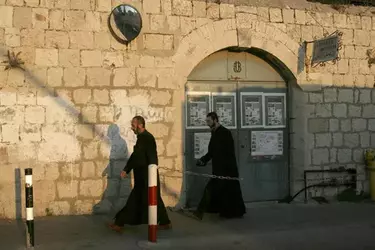L | A (Translated with ChatGPT)
By Nir Hasson

Haredim in Jerusalem, yesterday. ‘The discussion should be about barbaric behavior in the 21st century,’ says Christianity scholar Hanna Badankovsky
The video that was published this week, in which young Jews were seen spitting in front of a Christian procession in the Old City of Jerusalem, sparked a major uproar. One of those who responded was Elisha Yered, who is suspected of involvement in the murder of the Palestinian Qusai Muatan in the village of Burqa this past August. Yered claimed that the practice of spitting near a church or in front of priests is an ‘ancient and longstanding Jewish custom.’
The statement outraged a large segment of the public. The Prime Minister, the President, the Mayor of Jerusalem, and even the Minister of National Security condemned both the spitting phenomenon and Yered’s remark. But Yered is right: the custom does indeed have deep roots in Ashkenazi Judaism.
However, it is an entirely different custom — the original practice symbolized a quiet protest by a small, persecuted minority and was done in secret, whereas the spitting near churches and Christians in Jerusalem today is intended to publicly humiliate believers who belong to a minority group. ‘It was never a widespread custom,’ says Dr. Amnon Ramon of the Jerusalem Institute for Policy Research.

A procession of Christian believers in Jerusalem, in April. The old Ashkenazi custom blended well, for some of those spitting, with newer and more aggressive theological attitudes toward Christianity
Ramon explains, “This was done in certain places, mainly in Eastern Europe, and in secret. People would pass by a church at night and do it without anyone seeing. It was a custom, and there is no halakha (religious law) on the matter.” According to him, “The spitting expresses the problem of being unable to move from the reality of a persecuted minority trying to compensate for its persecution, to the situation where this minority is now the one in power and is judged, among other things, by how it treats minorities.”
Dr. Yaakov Morag, chairman of the organization for the Revival of the Aramaic Language in Israel, “Lishana,” which maintains ties with Christian communities, says: “It’s possible, at a stretch, that this custom once had some justification, and even then the spitting was not done in a demonstrative way. But today, the situation has changed. We are the sovereign, and under our rule there are minorities whom we have a duty to protect. In this context, there is no way to justify this phenomenon.
In Jewish sources, evidence of the spitting custom can be found. In the Sefer Maharil from the 15th century — considered the book of customs of Ashkenazi Jewry — its author, Rabbi Yaakov HaLevi ben Moshe Molin, mentions the custom of spitting while reciting the prayer Aleinu Le’shabeach, specifically at the words “aleinu leshabeach lahevel va’rik” (“it is our duty to praise [God]… [for they bow to] vanity and emptiness”). Today, few people still do this.
It is also mentioned in the Maharil that it was customary to spit when passing by churches. According to A., a young religious man and a former Haredi, this is a completely different custom from the spitting that happens today.
“When I used to walk with my father and we would pass by a church, he would teach me to spit, but it’s like shouting ‘Shabbes!’ at cars driving on Shabbat,” he explains.
“There’s no mitzvah in it — it’s an educational act. You’re teaching the child to recoil from idolatry. The idea was to do it discreetly, not demonstratively. The goal was not to humiliate someone else, but rather an internal purpose — I do it for myself. Even if you stood next to us with a camera, you wouldn’t have been able to document these spits.”

Nuns in Jerusalem, in March. For decades, Christian believers and clergy have been well aware of the spitting custom and have suffered from it
It also appears that the old Ashkenazi custom blended well, for some of those who spit, with newer and more aggressive theological views toward Christianity — views that have taken hold in some religious circles in Israel. ‘All the halakhic rulings regarding Christians have worsened in the second half of the 20th century,’ says Dr. Karma Ben-Yohanan, from the Department of Comparative Religion at the Hebrew University. She explains that the new generation of halakhic authorities adopted Maimonides’ view of Christianity, defining it as idolatry — unlike other approaches that had previously been common in Judaism.
Defining Christianity in this way aligns well with Hardal (nationalist ultra-orthodox) and Kahanist nationalism, which emphasizes the need to eradicate Christianity from the land. This is what motivated the arsonists of the Church of the Multiplication of the Loaves and Fish near the Sea of Galilee in 2015 and the attackers of churches in recent years.
For decades, Christian believers and clergy have been well aware of the spitting custom and have suffered from it. Despite the police’s claim that it is difficult to prosecute those who spit, in the past there have been some cases of indictments for spitting.
For example, in 1995 an indictment was filed against a man who spat during a Christian procession in the Armenian Quarter of Jerusalem. He was sentenced to two months’ probation and a fine of 750 shekels.
In an appeal brought before the District Court, his attorney, Naftali Wertzberger, argued that freedom of expression grants a person the freedom to spit ‘even in the presence of a procession of clergymen carrying a cross.’ He added that ‘one cannot ignore the prevailing Jewish halakhic view that a Jew is obligated to spit when passing by a church or encountering a cross.’ However, the District Court judges rejected this claim.

Monks in the Armenian Quarter of Jerusalem, in 2007. In the past, those who mainly suffered from the spitting were members of the Armenian Church, which is located near the Jewish Quarter
In 2004, a young man from the Har Hamor Yeshiva spat in the direction of the Armenian Patriarch during a religious procession in Jerusalem’s Old City. The Patriarch, Nourhan Manougian, slapped the young man, and the police arrested Manougian for questioning. Afterwards, a reconciliation meeting was held, during which the rabbis of the yeshiva — one of the most prominent Hardal yeshivas in Israel — apologized to the Patriarch and claimed that they do not teach their students this custom.
In 2011, a Jerusalem Magistrate’s Court judge acquitted a Greek priest who had struck a young Jewish man who spat on him. ‘It is intolerable for a Christian clergyman to be humiliated because of his faith, just as it is intolerable for a Jew to be humiliated for being Jewish,’ the judge wrote, adding that the authorities have failed to address the phenomenon. ‘Those who spit are not caught and are not punished for their actions. This is not a new phenomenon but one that has existed for years. The spitters not only break the law and harm their victims, they harm all of us — our image, our tourism, and our values.’ Therefore, he decided to acquit the priest on grounds of defense of justice.
Although the phenomenon is not new, it is changing in character and becoming more widespread and extreme. The most significant development in recent years is the spread of the phenomenon to the Muslim Quarter. In the past, those who mainly suffered from the spitting were members of the Armenian Church, which is located near the Jewish Quarter. In recent years, the phenomenon has also expanded to the route of the Via Dolorosa, which stretches from the Lion’s Gate to the Church of the Holy Sepulchre and passes mostly through the Muslim Quarter. Along this route, hundreds of thousands of pilgrims walk every year, and with the increased presence of religious Jews in these areas, they too have become victims of the spitting.

Elisha Yered at his remand hearing in the Supreme Court, in August. He claimed that the custom of spitting near a church or in front of priests is ‘an ancient and long-standing Jewish custom.’
The video that stirred the country in recent days was filmed on Lion’s Gate Street, during a procession known as Sivuv She’arim (‘Circling the Gates’). These processions have gained momentum in recent years among Hardal and Haredi circles — as a sort of response to the movements that ascend the Temple Mount. The procession circles around the Temple Mount, and afterward prayers are held at the gates of the Mount. There are often clashes and provocations directed at Muslim and Christian passersby.
On the eve of Yom Kippur, a group of Jews was filmed praying and singing over graves in the Muslim cemetery opposite the Golden Gate; this too was part of the Sivuv She’arim.
The time of year is also significant. Jewish holidays are considered times of heightened risk when it comes to spitting incidents. Especially notorious is the holiday of Purim, during which many Christians avoid going out into the streets so as not to encounter spitting and violence.

Lion’s Gate in Jerusalem, last year. During the processions held there, there are often clashes and acts of provocation toward Muslim and Christian passersby
Following the uproar that broke out in recent days, rabbis from the religious Zionist movement were quick to condemn those who spit and called for an end to this custom. Rabbi Shlomo Aviner, one of the leaders of the Hardal stream, the spiritual father of many settlers in East Jerusalem, and himself a resident of the Old City, wrote yesterday: ‘There is no halakhic ruling that one must spit on idolatry. It is not established in the Talmud, not in the Rambam (Maimonides), and not in the Shulchan Aruch. If spitting on idolatry would nullify all idolatry, then that would be an interesting question — but it accomplishes nothing. It only creates disputes and quarrels, and we lose because of it. Children should be taught to walk in the ways of respect.’
Hanna Bendcowsky, a veteran Jerusalem tour guide and scholar of Christianity, objects to even discussing the historical roots of the custom. ‘This discussion should not even be opened. If you’re opposed to Christianity, keep your spit in your mouth. Just raising the question gives legitimacy to whether spitting is acceptable. The real discussion should be about barbaric behavior in the 21st century.’
By Nir Hasson

Haredim in Jerusalem, yesterday. ‘The discussion should be about barbaric behavior in the 21st century,’ says Christianity scholar Hanna Badankovsky
The video that was published this week, in which young Jews were seen spitting in front of a Christian procession in the Old City of Jerusalem, sparked a major uproar. One of those who responded was Elisha Yered, who is suspected of involvement in the murder of the Palestinian Qusai Muatan in the village of Burqa this past August. Yered claimed that the practice of spitting near a church or in front of priests is an ‘ancient and longstanding Jewish custom.’
The statement outraged a large segment of the public. The Prime Minister, the President, the Mayor of Jerusalem, and even the Minister of National Security condemned both the spitting phenomenon and Yered’s remark. But Yered is right: the custom does indeed have deep roots in Ashkenazi Judaism.
However, it is an entirely different custom — the original practice symbolized a quiet protest by a small, persecuted minority and was done in secret, whereas the spitting near churches and Christians in Jerusalem today is intended to publicly humiliate believers who belong to a minority group. ‘It was never a widespread custom,’ says Dr. Amnon Ramon of the Jerusalem Institute for Policy Research.

A procession of Christian believers in Jerusalem, in April. The old Ashkenazi custom blended well, for some of those spitting, with newer and more aggressive theological attitudes toward Christianity
Ramon explains, “This was done in certain places, mainly in Eastern Europe, and in secret. People would pass by a church at night and do it without anyone seeing. It was a custom, and there is no halakha (religious law) on the matter.” According to him, “The spitting expresses the problem of being unable to move from the reality of a persecuted minority trying to compensate for its persecution, to the situation where this minority is now the one in power and is judged, among other things, by how it treats minorities.”
Dr. Yaakov Morag, chairman of the organization for the Revival of the Aramaic Language in Israel, “Lishana,” which maintains ties with Christian communities, says: “It’s possible, at a stretch, that this custom once had some justification, and even then the spitting was not done in a demonstrative way. But today, the situation has changed. We are the sovereign, and under our rule there are minorities whom we have a duty to protect. In this context, there is no way to justify this phenomenon.
In Jewish sources, evidence of the spitting custom can be found. In the Sefer Maharil from the 15th century — considered the book of customs of Ashkenazi Jewry — its author, Rabbi Yaakov HaLevi ben Moshe Molin, mentions the custom of spitting while reciting the prayer Aleinu Le’shabeach, specifically at the words “aleinu leshabeach lahevel va’rik” (“it is our duty to praise [God]… [for they bow to] vanity and emptiness”). Today, few people still do this.
It is also mentioned in the Maharil that it was customary to spit when passing by churches. According to A., a young religious man and a former Haredi, this is a completely different custom from the spitting that happens today.
“When I used to walk with my father and we would pass by a church, he would teach me to spit, but it’s like shouting ‘Shabbes!’ at cars driving on Shabbat,” he explains.
“There’s no mitzvah in it — it’s an educational act. You’re teaching the child to recoil from idolatry. The idea was to do it discreetly, not demonstratively. The goal was not to humiliate someone else, but rather an internal purpose — I do it for myself. Even if you stood next to us with a camera, you wouldn’t have been able to document these spits.”

Nuns in Jerusalem, in March. For decades, Christian believers and clergy have been well aware of the spitting custom and have suffered from it
It also appears that the old Ashkenazi custom blended well, for some of those who spit, with newer and more aggressive theological views toward Christianity — views that have taken hold in some religious circles in Israel. ‘All the halakhic rulings regarding Christians have worsened in the second half of the 20th century,’ says Dr. Karma Ben-Yohanan, from the Department of Comparative Religion at the Hebrew University. She explains that the new generation of halakhic authorities adopted Maimonides’ view of Christianity, defining it as idolatry — unlike other approaches that had previously been common in Judaism.
Defining Christianity in this way aligns well with Hardal (nationalist ultra-orthodox) and Kahanist nationalism, which emphasizes the need to eradicate Christianity from the land. This is what motivated the arsonists of the Church of the Multiplication of the Loaves and Fish near the Sea of Galilee in 2015 and the attackers of churches in recent years.
For decades, Christian believers and clergy have been well aware of the spitting custom and have suffered from it. Despite the police’s claim that it is difficult to prosecute those who spit, in the past there have been some cases of indictments for spitting.
For example, in 1995 an indictment was filed against a man who spat during a Christian procession in the Armenian Quarter of Jerusalem. He was sentenced to two months’ probation and a fine of 750 shekels.
In an appeal brought before the District Court, his attorney, Naftali Wertzberger, argued that freedom of expression grants a person the freedom to spit ‘even in the presence of a procession of clergymen carrying a cross.’ He added that ‘one cannot ignore the prevailing Jewish halakhic view that a Jew is obligated to spit when passing by a church or encountering a cross.’ However, the District Court judges rejected this claim.

Monks in the Armenian Quarter of Jerusalem, in 2007. In the past, those who mainly suffered from the spitting were members of the Armenian Church, which is located near the Jewish Quarter
In 2004, a young man from the Har Hamor Yeshiva spat in the direction of the Armenian Patriarch during a religious procession in Jerusalem’s Old City. The Patriarch, Nourhan Manougian, slapped the young man, and the police arrested Manougian for questioning. Afterwards, a reconciliation meeting was held, during which the rabbis of the yeshiva — one of the most prominent Hardal yeshivas in Israel — apologized to the Patriarch and claimed that they do not teach their students this custom.
In 2011, a Jerusalem Magistrate’s Court judge acquitted a Greek priest who had struck a young Jewish man who spat on him. ‘It is intolerable for a Christian clergyman to be humiliated because of his faith, just as it is intolerable for a Jew to be humiliated for being Jewish,’ the judge wrote, adding that the authorities have failed to address the phenomenon. ‘Those who spit are not caught and are not punished for their actions. This is not a new phenomenon but one that has existed for years. The spitters not only break the law and harm their victims, they harm all of us — our image, our tourism, and our values.’ Therefore, he decided to acquit the priest on grounds of defense of justice.
Although the phenomenon is not new, it is changing in character and becoming more widespread and extreme. The most significant development in recent years is the spread of the phenomenon to the Muslim Quarter. In the past, those who mainly suffered from the spitting were members of the Armenian Church, which is located near the Jewish Quarter. In recent years, the phenomenon has also expanded to the route of the Via Dolorosa, which stretches from the Lion’s Gate to the Church of the Holy Sepulchre and passes mostly through the Muslim Quarter. Along this route, hundreds of thousands of pilgrims walk every year, and with the increased presence of religious Jews in these areas, they too have become victims of the spitting.

Elisha Yered at his remand hearing in the Supreme Court, in August. He claimed that the custom of spitting near a church or in front of priests is ‘an ancient and long-standing Jewish custom.’
The video that stirred the country in recent days was filmed on Lion’s Gate Street, during a procession known as Sivuv She’arim (‘Circling the Gates’). These processions have gained momentum in recent years among Hardal and Haredi circles — as a sort of response to the movements that ascend the Temple Mount. The procession circles around the Temple Mount, and afterward prayers are held at the gates of the Mount. There are often clashes and provocations directed at Muslim and Christian passersby.
On the eve of Yom Kippur, a group of Jews was filmed praying and singing over graves in the Muslim cemetery opposite the Golden Gate; this too was part of the Sivuv She’arim.
The time of year is also significant. Jewish holidays are considered times of heightened risk when it comes to spitting incidents. Especially notorious is the holiday of Purim, during which many Christians avoid going out into the streets so as not to encounter spitting and violence.

Lion’s Gate in Jerusalem, last year. During the processions held there, there are often clashes and acts of provocation toward Muslim and Christian passersby
Following the uproar that broke out in recent days, rabbis from the religious Zionist movement were quick to condemn those who spit and called for an end to this custom. Rabbi Shlomo Aviner, one of the leaders of the Hardal stream, the spiritual father of many settlers in East Jerusalem, and himself a resident of the Old City, wrote yesterday: ‘There is no halakhic ruling that one must spit on idolatry. It is not established in the Talmud, not in the Rambam (Maimonides), and not in the Shulchan Aruch. If spitting on idolatry would nullify all idolatry, then that would be an interesting question — but it accomplishes nothing. It only creates disputes and quarrels, and we lose because of it. Children should be taught to walk in the ways of respect.’
Hanna Bendcowsky, a veteran Jerusalem tour guide and scholar of Christianity, objects to even discussing the historical roots of the custom. ‘This discussion should not even be opened. If you’re opposed to Christianity, keep your spit in your mouth. Just raising the question gives legitimacy to whether spitting is acceptable. The real discussion should be about barbaric behavior in the 21st century.’